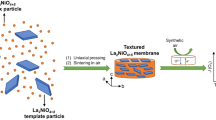Abstract
Anodizing of aluminum is used for producing porous insulating films suitable for different applications in electronics and microelectronics. Porous-type aluminum films are most simply realized by galvanostatic anodizing in aqueous acidic solutions. The improvement in application of anodizing technique is associated with a substantial reduction of the anodizing voltage at appropriate current densities as well as to the possibility to carry out the synthesis process at room temperature in order to obtain a self-planarizing dielectric material incorporated in array of super-narrow metal lines. In this work, the anodizing of aluminum to obtain porous oxide was carried out, at room temperature, on three different substrates (glass, stainless steel and aluminum), using an oxalic acid-based electrolyte with the addition of a relatively low amount of 0.4 % of HF. Different surface morphologies, from nearly spherical to larger porous nanostructures with smooth edges, were observed by means of scanning electron microscopy. These evidences are explained by considering the formation, transport and adsorption of the fluorine species which react with the Al3+ ions. The behavior is also influenced by the nature of the original substrate.





Similar content being viewed by others
References
K. Yasui, T. Morikawa, K. Nishio, H. Masuda, Patterned magnetic recording media using anodic porous alumina with single domain hole configurations of 63 nm hole interval. Jpn. J. Appl. Phys. 44, L469 (2005)
S. Zhang, L. Wang, C. Xu, A. Li, L. Chen, D. Yang, Fabrication of Ni–NiO–Cu metal-insulator-metal tunnel diodes via anodic aluminum oxide templates. ECS Solid State Lett. 2, Q1 (2013)
G. Macias, L.P. Hernandes-Eguia, J. Ferre-Borrull, J. Pallares, L.F. Marsal, Gold-coated ordered nanoporous anodic alumina bilayers for future label-free interferometric biosensors. ACS Appl. Mater. Interfaces 5, 8093 (2013)
R. Karmhag, R. Tesfamichael, E. Wackelgard, G.A. Niklasson, M. Nygren, Oxidation kinetics of nickel particles: comparaison between free particles and particules in an oxide matrix. Sol. Energy 68, 329 (2000)
H. Masuda, M. Yamada, F. Matsumoto, S. Yokoyama, S. Mashiko, M. Nakao, K. Nishio, Lasing from two-dimensional photonic crystals using anodic porous alumina. Adv. Mater. 18, 213 (2006)
T. Kikuchi, Y. Wachi, T. Takahashi, M. Sakairi, R.O. Suzuki, Fabrication of a meniscus microlens array made of anodic alumina by laser irradiation and electrochemical techniques. Electrochim. Acta 94, 269 (2013)
T. Kondo, H. Masuda, K. Nishio, SERS in ordered array of geometrically controlled nanodots obtained using anodic porous alumina. J. Phys. Chem. C 117, 2531 (2013)
T. Kikuchi, Y. Wachi, M. Sakairi, R.O. Suzuki, Aluminum bulk micromachining through an anodic oxide mask by electrochemical etching in an acetic acid/perchloric acid solution. Microelectron. Eng. 111, 14 (2013)
J. Wang, M. Singh, M. Tian, N. Kumar, B. Liu, C. Shi, J.K. Jain, N. Samarth, T.E. Mallouk, M.H.W. Chan, Interplay between superconductivity and ferromagnetism in crystalline nanowires. Nat. Phys. 6, 389 (2010)
N. Cabrera, N.F. Mott, Theory of the oxidation of metals. Rep. Prog. Phys. 12, 163 (1949)
A. Mozalev, A. Poznyak, I. Mozaleva, A.W. Hassel, The voltage-time behaviour for porous anodizing of aluminum in a fluoride-containing oxalic acid electrolyte. Electrochem. Commun. 3, 299 (2001)
A. Keshavarz, Z. Parang, A. Nasseri, The effect of sulfuric acid, oxalic acid, and their combination on the size and regularity of the porous alumina by anodization. J. Nanostruct. Chem. 3, 34 (2013)
M.K. Jr McQuaig, A. Toro, W.V. Geertruyden, W.Z. Misiolek, The effect of high temperature heat treatment on the structure and properties of anodic aluminum oxide. J. Mater. Sci. 46, 243 (2011)
A.K. Sharma, H. Bhojaraj, Thermoanalytical studies of anodic oxide coatings on aluminum. Plat. Surf. Finish. 76, 59 (1989)
A. Jagminas, M. Kurtinaitiene, R. Angelucci, G. Valincius, Modification of alumina barrier-layer through re-anodization in an oxalic acid solution with fluoride additives. Appl. Surf. Sci. 252, 2360 (2006)
H. Masuda, H. Yamada, M. Satoh, H. Asoh, M. Nakao, T. Tamamura, Highly ordered nanochannel-array architecture in anodic alumina. Appl. Phys. Lett. 71, 2770 (1997)
H. Asoh, S. Ono, T. Hirose, M. Nakao, H. Masuda, Growth of anodic porous alumina with square cells. Electrochim. Acta 48, 3171 (2003)
W. Fei, S.C. Kuiry, S. Seal, K. Scammon, N. Quick, M. June, High temperature surface oxidation of metallic fibres for hot gas filtration. Surf. Eng. 18, 197 (2002)
S. Chevalier, A. Galerie, O. Heintz, R. Chassagnon, A. Crisci, Thermal alumina scales on FeCrAl: characterization and growth mechanism. Mater. Sci. Forum 595, 915 (2008)
B.R. Strohmeier, Surface characterization of aluminum foil annealed in the presence of ammonium fluoborate. Appl. Surf. Sci. 40, 249 (1989)
J.R. Lindsay, H.J. Rose, W.E. Swartz, P.H. Watts, K.A. Rayburn, X-ray photoelectron spectra of aluminum oxides: structural effects on the “chemical shift”. J. Appl. Spectrosc. 27, 1 (1973)
K. Schimizu, K. Kobayashi, G.E. Thompson, P. Skeldon, G.C. Wood, Anodic oxide films on tantalum: incorporation and mobilities of electrolyte-derived species. Philosophi. Mag. Part B 73, 461 (1996)
K. Schimizu, K. Kobayashi, G.E. Thompson, P. Skeldon, G.C. Wood, The migration of fluoride ions in growing anodic oxide films on tantalum. J. Electrochem. Soc. 144, 418 (1997)
A. Jagminas, I. Vrublevsky, J. Kuzmarskyte, V. Jasulaitiene, Composition, structure and electrical properties of alumina barrier layers grown in fluoride-containing oxalic acid solutions. Acta Mater. 56, 1390 (2008)
T. Kumeria, A. Santos, D. Losic, Nanoporous anodic alumina platforms: engineered surface chemistry and structure for optical sensing applications. Sensors 14, 11878 (2014)
K.M. Chahrour, N.M. Ahmed, M.R. Hashim, N.G. Elfadill, M.A. Qaeed, Controllable fabrication of highly ordered thin AAO template on Si substrate for electrodeposition of nanostructures. Appl. Phys. A 116, 1389 (2014)
Author information
Authors and Affiliations
Corresponding author
Rights and permissions
About this article
Cite this article
Dhahri, S., Fazio, E., Barreca, F. et al. Porous aluminum room temperature anodizing process in a fluorinated-oxalic acid solution. Appl. Phys. A 122, 746 (2016). https://doi.org/10.1007/s00339-016-0280-8
Received:
Accepted:
Published:
DOI: https://doi.org/10.1007/s00339-016-0280-8




